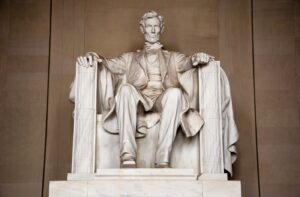With confirmation hearings around the corner for Judge Sonia Sotomayor’s nomination to the Supreme Court, it’s a good time to take stock of some fundamental issues regarding the place of the Court in our political life. What should we expect of the justices as they perform their duties under the Constitution? What are the appropriate modes of interaction between the Court and the other branches of our government?
A good place to start is with the Supreme Court’s self-understanding—the justices’ own understanding of their power under the Constitution—which turns out to be ahistorical and self-serving. In a unanimous 1958 ruling in Cooper v. Aaron regarding the desegregation of schools in Little Rock, Arkansas, the justices went out of their way to declare as “settled doctrine . . . the basic principle that the federal judiciary is supreme in the exposition of the law of the Constitution.” The Court traced this doctrine back to the landmark 1803 decision of Marbury v. Madison and said that its “supreme” authority to answer constitutional questions, putatively announced in that case, had “ever since been respected by this Court and the country as a permanent and indispensable feature of our constitutional system.” The Cooper opinion travelled the rest of the way to the logical conclusion: that Supreme Court decisions are “the supreme law of the land,” indistinguishable from the Constitution itself and as binding on other political actors as the charter of government they take an oath to uphold.
Nothing the Court has done or said in the last half century has deviated from this understanding of its unrivalled authority to interpret the Constitution, and the Cooper doctrine was a long time gestating before the justices delivered it in 1958. But it is, or ought to be, a shocking view to take of our constitutional order. Judicial supremacy—the doctrine that the nation’s governing charter means whatever a majority of Supreme Court justices say it means—is profoundly inimical to the separation of powers, to republicanism, and even to constitutionalism and the rule of law themselves. If the Court that gave us Cooper was right about Marbury v. Madison, then we would be entitled to hope that Marbury was wrong about the Constitution. And if Marbury, understood as the Cooper justices put it, was right about the Constitution, we would be entitled to grave misgivings about the goodness of our constitutional order.
The good news is that the Cooper opinion was wrong about Marbury, which in fact set forth a far more limited understanding of judicial power, consistent with the framers’ republicanism and separation of powers. The bad news is that our political system suffers from the disordering effects of judicial supremacy with no easy or obvious way out of the disorder. Both the good news and the bad require some explaining.
Start your day with Public Discourse
Sign up and get our daily essays sent straight to your inbox.First things first. The Constitution never mentions the power that today we call “judicial review,” the power of the federal judiciary to hold acts of Congress or conduct of the executive branch unconstitutional. Even the federal courts’ authority to invalidate state laws is not explicitly laid out in the Constitution but is rather an inference from it. Article VI explicitly requires state judges to prefer the federal Constitution over any conflicting state law or constitutional provision, and the Supreme Court has authority derived from Article III to review state court rulings on such matters. The Court’s power to judge whether its counterparts in the federal government have conformed their actions to the Constitution is likewise an inference from the text, but an inference twice over. First, Article VI declares the Constitution to be the “supreme Law of the Land,” while acts of Congress are said to enjoy that status too, so long as they are “made in pursuance” of, that is to say, consistent with, the Constitution. And Article III gives the federal courts power to decide “Cases . . . arising under this Constitution [and] the Laws of the United States . . .” If these two sources of law come into conflict, what is the duty of a court deciding a case in which both are brought fully to bear on the dispute between the parties? These two clauses of the Constitution take us some distance on our way to “judicial review,” but not all the way.
In the Marbury case in 1803, Chief Justice John Marshall did not engage in close textual analysis of these constitutional provisions. He appears to have taken it for granted that they stated well-established principles of constitutionalism and the rule of law. For Marshall, it followed from the fact of a written constitution itself that statutes contrary to its terms are not law at all. Why else bother with writing down a constitution? No other inference was compatible with the right of the people to call a government into being for themselves by such means. But, recognizing that the other branches were equal in authority to the judiciary, each in its own sphere, and that their opinions might naturally differ about constitutional interpretation, he did not move straight from the single premise acts contrary to the Constitution are void to the congenial conclusion the Supreme Court authoritatively declares which acts are void due to their unconstitutionality. An intermediate step, a minor premise, was necessary, and Marshall found it in the principle that when courts must “apply the rule [of law] to particular cases [they] must, of necessity, expound and interpret that rule.” Elsewhere in his Marbury opinion, he declared that the “province of the Court is solely to decide on the rights of individuals.” This is what courts of law do—adjudicate the contested rights of the parties before them—and when they have settled questions of rights, the rulings of courts as to the affected parties are entitled to finality, and to the respect of the other branches. Anything less would endanger the legitimacy and integrity of the judicial function itself.
But the Constitution has a lot to say about matters other than the rights of individuals. It paints in broad strokes regarding the structures of government, the relations of institutions to one another, and the partly competing, partly cooperating powers of those institutions, state and federal. As to these other large matters under the Constitution, there is no reason derived from the text itself, or from the Marbury precedent, to conclude that the judicial power is the authoritative “enforcer” of the Constitution, riding herd on the other branches’ uses of their own powers. For as Marshall observed on another occasion, not every question arising about the meaning of the Constitution makes out a case arising under it that the judiciary alone is fit to resolve. That is, not every question of constitutional power or principle generates a case about individual rights that the Constitution entrusts to the courts. As the old saying warns us, “don’t make a federal case out of it!” To make a federal case out of everything the Constitution says is to fritter away the habits of self-government and make our fundamental law the plaything of unaccountable judges.
These distinctions were once well understood in America’s politico-legal community. While occasional assertions were made that the judges were the “guardians of the Constitution” with a final authority over all interpretive questions, such claims were transparently partisan, and were usually abandoned as readily as they were advanced when political conditions changed. It is doubtless no accident that while the founders’ limited understanding of judicial power prevailed only one provision of federal law (in the Marbury case itself) was ever held unconstitutional. On the second occasion when the Court exercised this power—in the infamous Dred Scott decision of 1857—its ruling was transparently improper, intruding on Congress’s power to govern the federal territories and straining to manufacture a “right” to keep and transport slaves under the due process clause.
Abraham Lincoln saw through the great fraud of the Dred Scott case, identified the tyrannical impulse of the Court, and spoke for the founders’ constitutional understanding in his first inaugural address in 1861:
I do not forget the position assumed by some, that constitutional questions are to be decided by the Supreme Court; nor do I deny that such decisions must be binding in any case, upon the parties to a suit, as to the object of that suit, while they are also entitled to very high respect and consideration, in all parallel cases, by all other departments of the government. . . . At the same time the candid citizen must confess that if the policy of the government, upon vital questions, affecting the whole people, is to be irrevocably fixed by decisions of the Supreme Court, the instant they are made, in ordinary litigation between parties, in personal actions, the people will have ceased, to be their own rulers, having, to that extent, practically resigned their government, into the hands of that eminent tribunal.
Lincoln’s election to the presidency was, among other things, a repudiation of the doctrine of judicial supremacy espoused by his great rival Stephen A. Douglas. Yet in the seven score and nine years since that election, Douglas’s doctrine has become American orthodoxy. With Douglas, our political and legal elites today regard the denial of the binding character of any Supreme Court decision as a betrayal of the Constitution itself; Lincoln’s position is made to sound strange and jangling to our ears, and we are soothed into resigning our government’s weightiest matters into the hands of our eminent philosopher-kings in robes, who are happy to employ such an unchecked power. The Cooper doctrine’s announcement in 1958 only crystallized the final victory of Douglas over Lincoln on this question, a century after their titanic debates in the Illinois senate race. How did this sea-change come to pass?
The answer to that question is necessarily long and complicated. The tale includes some ironies: how the professionalization of legal education and practice damaged the rule of law; how both conservatives and liberals have had their innings fighting for government by judiciary; how “legal realism” and the “living Constitution” taught that judges “make law” no less than legislatures, without the teachers of this doctrine seeming to notice that it makes a mockery of constitutionalism so long as judges remain beyond the reach of ordinary electoral politics; and how the other branches have found it in their interest to transfer their constitutional responsibilities to the “professionals” in black robes. But a key part of the story that is too little noticed is the adoption in the early twentieth century of the phrase “judicial review” to encapsulate the power of the federal judiciary to pronounce authoritatively on the meaning of the Constitution. Once the Supreme Court is in the “review” business, old distinctions are lost, there are no issues of constitutional meaning that don’t “belong” to the justices, and it should be no surprise that political issues never previously thought to have any constitutional dimension calling for the involvement of courts—say, the detention of enemy combatants overseas by our military—are suddenly “discovered” to be grave matters of constitutional law after all, crying out for judicial resolution.
In the modern era of “judicial review,” constitutional law becomes a bloody ground of struggle between the advocates of “judicial activism” and the defenders of “judicial restraint,” and restraint is always fighting a rearguard action. All the natural inertia of the Supreme Court as an institution is toward the continual accumulation of power. Even the emergence of “originalism” as a school of thought challenging the worst excesses of judicial review has not signaled a full recovery of the framers’ constitutionalism. Originalism’s great achievement is to offer the judges compelling reasons for some constraint on the exercise of their power through the discipline of text and history, but nonetheless the great majority of self-described originalists, on the bench and in the academy, seem perfectly at home with the ahistorical doctrine of judicial supremacy, believing that there are virtually no provisions of the Constitution that are unenforceable by judges, and that the rulings of the Supreme Court on constitutional questions, however outlandishly wrong they may be, can be reversed by two means only: by constitutional amendments changing the text that is interpreted, or, one supposes, by a change of mind on the part of the justices.
This near universality of the dogma of judicial supremacy should put us on notice that a great disorder exists in our constitutional system. After all, if the only two methods for correcting the constitutional abuses of the Supreme Court are to change the Constitution or to change the minds of the justices (perhaps by changing the justices themselves), then we may as well admit that we have acquiesced in a judicial power that is itself capable of changing the Constitution, which fairly regularly does just that, unchecked by any countervailing political power.
So long as this state of affairs continues, we invest a lot of political energy in the occasional vacancies that come open on the Supreme Court. Getting the “right” justices is our one and only means of assuring that our preferred vision of the Constitution will prevail in the future, and thus we quite rightly take a keen interest in determining beforehand what the next justice thinks about the constitutional questions that matter most to us. But this attention seems to be a fool’s errand. The life tenure of the justices, and the insistence of nominees on an “independence” that was once the Constitution’s friend but is now its deadliest enemy, mean that we simply cannot assure ourselves of anything about the future behavior of the Supreme Court. The Court today is more important on more questions, more powerful and unaccountable, and less compatible with the authentic norms of the framers’ Constitution, than at any time in our history.
There is nothing for it but a recovery of those authentic norms of republicanism, the separation of powers, and the rule of law. Since this means first and foremost the recovery of a nearly lost set of ideas, and ideas are discovered and rediscovered in the course of talking through our problems, there is no better occasion for getting a start on this business than in the conversation that is prompted by a fresh nomination to the Supreme Court. In the public discourse that results, we might find our way back to the right principles. Could such a fruitful discourse take place?
I’ll attempt to answer that question in part two of this article, to be published on Friday.












